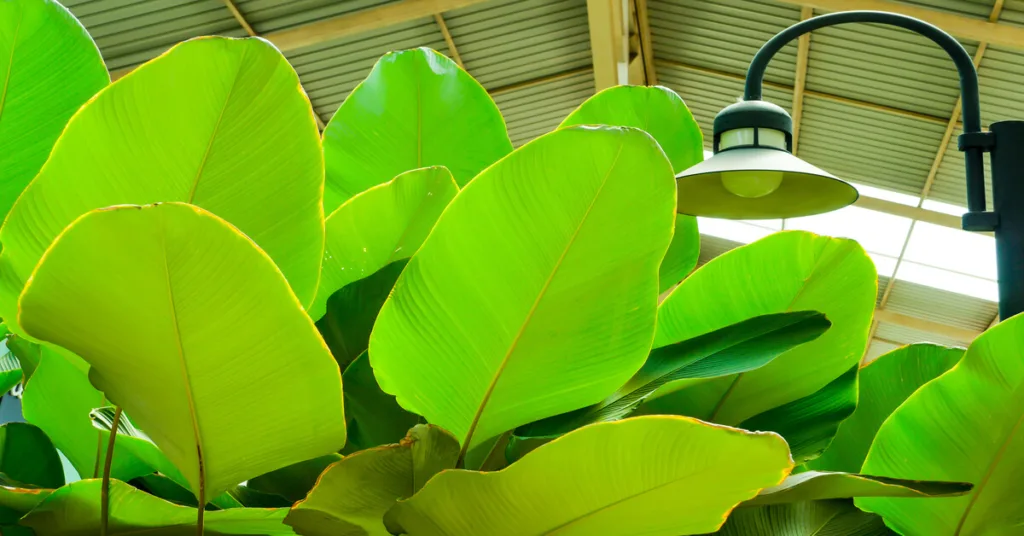Welcome to the world of growing Calathea Lutea, also known as cigar plant or pampano plant! This unique houseplant originates from the Tropical Americas. Additionally, it belongs to the Marantaceae plant family. With its lush green oval leaves, it is a great choice for adding an eye-catching feature to living spaces. Also, it stands at a whopping 10′ to 12′ tall once mature!
If you want to learn more about growing this tropical beauty, GIY Plants has you covered! We will be breaking down everything from cigar plant care to interesting factoids.
Calathea Lutea Care

Do you want to make your home look like a lush jungle oasis? If so, you should learn everything about Calathea lutea or cigar plant care!
Keep reading to find out how you can keep your cigar plant thriving with simple care practices.
Soil
A moist sandy loamy soil that is well-draining is essential for growing Calathea lutea seeds. It also prefers soil with a pH of 5.5 to 7.7, which is slightly acidic to neutral.
Watering
Daily mistings are sure to keep your cigar plant thriving. Although, you need to ensure that the soil and planter have adequate drainage. Despite preferring humid conditions, it can still suffer from overwatering and fungal diseases.
Lighting
Calathea lutea/ pampano plant seeds flourish when growing in semi-shade. It is best to place the growing houseplant in a room that only has a window or two and in the darkest corner.
Humidity & Temperature
As previously stated, cigar plants prefer humid conditions. That comes as no surprise considering it originates from the Tropical Americas. So, keep humidity levels on the higher side in your home. You can also mist the plant frequently or place a small humidifier in the room with the plant. As for temperature, cigar plants enjoy warmer conditions of 65°F to 75°F or 18°C to 24°C.
Fertilizing
Calathea lutea is a hungry plant that needs frequent fertilization – once a month is ideal. A 10-10-10 all-purpose NPK fertilizer can provide the necessary nutrients this plant needs.
Propagation
The best and most common way to propagate a Calathea lutea is through rhizome division. To do so, start watering the plant frequently the week before you are ready to divide it. When dividing the Calathea lutea rhizome, carefully remove the plant from its pot. After, take a sharp gardening blade and detach part of the rhizome.
Now, you should have a new smaller plant that has its own root system and leaves. Finally, you can place your new plant in a medium-sized container with sandy loamy soil. Ensure to water it after planting.
Diseases & Pests
All types of Calathea plants can suffer from bacterial and fungal diseases. Pseudomonas leaf spot and pseudomonas blight are significant bacterial diseases for these plants. As for fungal diseases, Fusarium wilt, Helminthosporium leaf spot, and Alternaria leaf spot are of concern. They can also suffer from cucumber mosaic virus, a viral problem [1].
With any plant disease or virus, proper growing practices are the best preventives.
Calathea plants can also suffer from pest issues. Burrowing nematodes, scales, mealy bugs, two-spotted spider mites, fungus gnats, shore flies, caterpillars, and slugs are the most common. Insecticides and proper care practices are best for mitigating these unruly pests.
Toxicity
There is no current data showing that cigar plants are toxic to humans or common household pets.
Calathea lutea vs Thaumatococcus
The main difference between Calathea lutea and Thaumatococcus plants is their coloring. At first glance, these two plants have a strikingly similar appearance. But there is one defining difference if you look closely! Calathea luteas have leaves with silvery coloring on the underside. Thaumatococcus plants do not share the same silver coloring. Additionally, Calathea lutea is from the Calathea genus, whereas Thaumatococcus is another genus.
References:
[1] Calathea Production Guide. University of Florida, IFAS Central Florida Research and Education Center. (n.d.). Retrieved March 10, 2023, from https://mrec.ifas.ufl.edu/foliage/folnotes/calathea.htm

